Tom's Hardware Verdict
With a few omissions and a high price tag, we can’t quite call the Asus ROG Swift PG32UQX perfect. But its picture quality is without equal among computer monitors. A Mini LED backlight with a quantum dot film provides amazing contrast and a huge color gamut for the latest gaming and video formats. It has the best image of any computer display we have ever reviewed.
Pros
- +
+ Stunning image quality
- +
+ Accurate color
- +
+ Incredible contrast
- +
+ Accepts film cadences over HDMI
- +
+ OLED info screen
- +
+ Tons of gaming features
- +
+ Good build quality
Cons
- -
No Dolby Vision
- -
No speakers
- -
No motion blur reduction
- -
Expensive
Why you can trust Tom's Hardware
What constitutes the ultimate computer monitor? There is no single answer of course, as the best computer monitor for anyone must fit their specific needs and wishes. But sometimes, a display comes along that packs everything into a single product. Gaming monitors need speed, responsiveness, features that enhance play and solid image quality. Workday monitors need screen real estate, clarity and reliability. Professional screens must be accurate, capable of showing the latest video formats and built for long-term use. Rarely are all these things included in one display.
The Asus ROG Swift PG32UQX is one of those rare displays. With bleeding edge panel tech in the form of a full-array local dimming (FALD) Mini LED quantum dot backlight sporting 1,152 dimming zones, 4K resolution, 144 Hz, G-Sync Ultimate, a huge color gamut, factory-certified accuracy and 1,400 nits of max brightness, it's one of the best 4K gaming monitors and gaming monitors in general. Yet, it also provides everything needed for great productivity and professional-grade image editing. It might be the ultimate monitor -- unless you factor in price.
While a $3,000 MSRP is not a surprising amount for cutting-edge technology, it does suggest that nothing has been left out. Is this monitor worth that much?
Asus ROG Swift PG32UQX Specs
| Panel Type / Backlight | IPS / Mini LED |
| Row 1 - Cell 0 | 1,152 dimming zones |
| Screen Size & Aspect Ratio | 32 inches / 16:9 |
| Max Resolution & Refresh | 3840 x 2160 @ 144 Hz |
| Row 4 - Cell 0 | G-Sync Ultimate: 1-144 Hz |
| Native Color Depth & Gamut | 10-bit / DCI-P3 |
| Row 6 - Cell 0 | HDR10, DisplayHDR 1400 |
| Response Time (GTG) | 4ms |
| Brightness (mfr) | 500 nits SDR |
| Row 9 - Cell 0 | 1,400 nits HDR |
| Contrast (mfr) | 1,000:1 |
| Speakers | None |
| Video Inputs | 1x DisplayPort 1.4 |
| Row 13 - Cell 0 | 3x HDMI 2.0 |
| Audio | 3.5mm headphone output |
| USB 3.0 | 1x up, 2x down |
| Power Consumption | 60w, brightness @ 200 nits |
| Panel Dimensions WxHxD w/base | 28.6 x 19.8-22.6 x 12 inches (727 x 504-574 x 306mm) |
| Panel Thickness | 2.7 inches (95mm) |
| Bezel Width | Top/sides: 0.3 inch (8mm) |
| Row 20 - Cell 0 | Bottom: 0.8 inch (21mm) |
| Weight | 24 pounds (10.9kg) |
| Warranty | 3 years |
The Asus PG32UQX is a spare-no-expense design. IPS, Mini LED and quantum dots combine to create the ultimate FALD monitor. A FALD design is the best way to achieve high contrast in an LCD ,and the more zones there are, the better. Mini LED is a much smaller version of traditional LEDs, which means you can arrange more of them behind the screen and achieve a greater number of zones.
Traditional LEDs top out at 384 zones in the 27-inch size. Some high-end TVs have 512 zones in a 65-inch screen, but Mini LED has far greater potential. The PG32UQX has 1,152 zones in a 48 x 24 array behind its 32-inch panel. Combine that with a quantum dot film, and you have amazing potential for contrast and color gamut volume. In fact, our HDR tests revealed the highest contrast ratio we’ve ever recorded for an LCD panel and over 100% coverage of the DCI-P3 gamut. As you dive into our tests, you’ll see several amazing results.
You might be thinking that the Asus PG32UQX sounds similar to the Asus ProArt PA32UCX professional screen we reviewed last year. In fact, the ROG Swift uses an updated version of the AU Optronics panel found in Asus’ ProArt flagship. The update adds a larger color gamut and a 144 Hz refresh rate with G-Sync Ultimate. It's not certified by AMD, but we also confirmed FreeSync operation with a Radeon RX 5700 XT graphics card.
HDR is also front and center here with VESA DisplayHDR 1400 certification and HDR10 support. Unfortunately, there is no Dolby Vision. Though not often used for games, Dolby Vision is becoming more common on 4K Blu-ray and in streamed content from Netflix and other major TV providers. It’s unfortunate that the PG32UQX’s phenomenal image quality can’t be fully utilized with every format currently in use. On the upside, it does accept 24p film cadences from Blu-ray and streamed content.
Get Tom's Hardware's best news and in-depth reviews, straight to your inbox.
Assembly and Accessories of Asus ROG Swift PG32UQX
The PG32UQX's panel, upright and base are all quality pieces that assemble without tools. A small lens snaps in place on the base to project either a ROG logo or a soft-colored light that's controllable from the on-screen display (OSD). The projection lenses for the base are packed in a nice cloth bag to keep them scratch-free.
Accessories include a nice set of cables, HDMI 2.0, DisplayPort 1.4 and USB 3.0 Type-A, along with a large external power supply.
Product 360: Asus ROG Swift PG32UQX

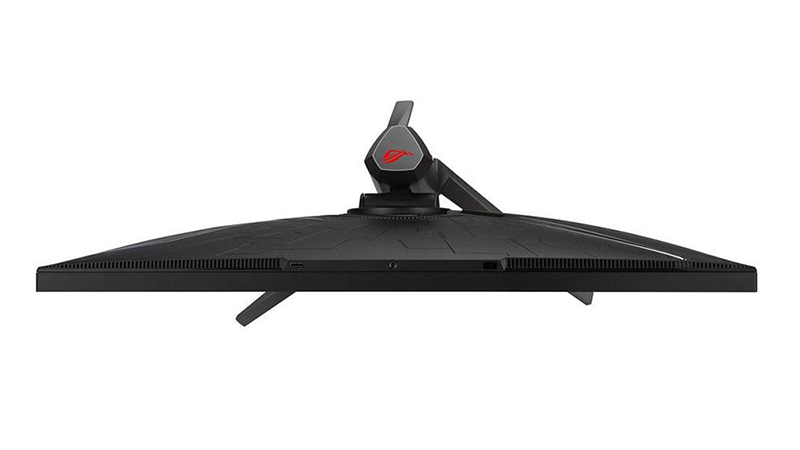
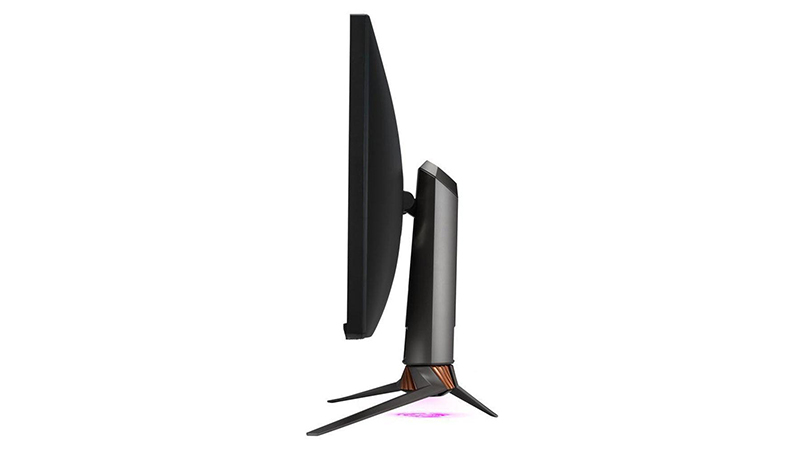
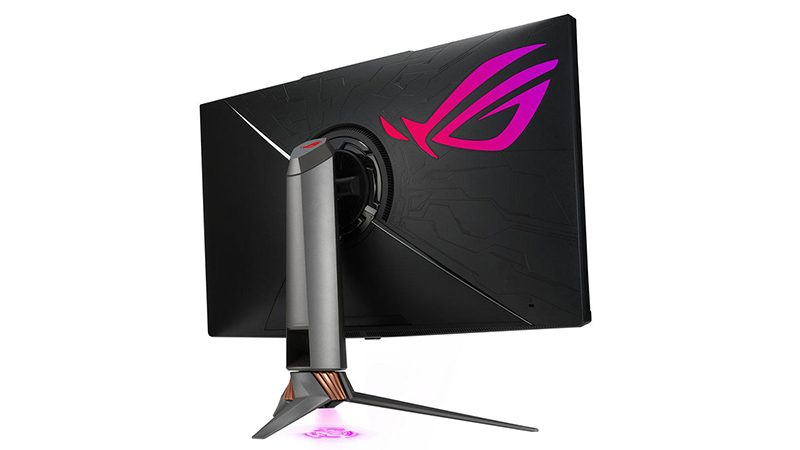
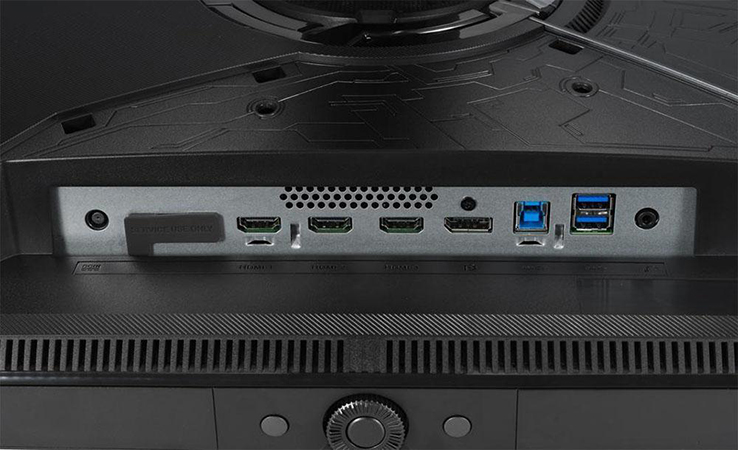
The Asus ROG Swift PG32UQX is massive, making zero attempt to be slim or lithe. The panel is thicker than most at nearly 3 inches but keeps the bezel thin around the top and sides, just 8mm.
The bottom strip is 21mm wide and features a tiny OLED screen called LiveDash. LiveDash displays many different things, like refresh rate, picture mode and CPU and GPU temperatures. It’s super cool to have that information always visible and not overlayed on the picture. Below that is a dial with a button in its center and two more keys flanking. This is Asus' new take on OSD navigation, and it's also very cool. The dial feels like the volume knob on a high-end audio component and makes changing settings a snap.
Lighting comes from the base, where a ROG logo can be projected onto the desktop. The back of the panel has a large ROG logo that can display different colors and effects. And the top of the upright also has a ROG logo that can be configured independently. The fun is all controlled from the OSD and can be coordinated with other RGB-equipped ROG components for a light show that’s probably visible from space. We noted during testing that when the Asus ROG Swift PG32UQX is in standby mode, LiveDash and all the RGB lighting remain on, drawing around 29 watts of electricity.
Styling is distinctly Asus ROG but a tad more understated than usual. You’ll find the molded lines in back that remind us of a spaceship hull, but that’s about it. The base is solid metal with a copper colored accent, also a standard element of ROG monitors. The stand is rock solid and includes a 2.7-inch height adjustment, along with 20-degree swivel and -5/20-degree tilt. There is no portrait mode.
The input panel features three HDMI 2.0 ports, plus a single DisplayPort 1.4. HDMI supports consoles up to 120 Hz with HDR and Adaptive-Sync and will accept film cadences like 24p. DisplayPort accepts up to 144 Hz with Adaptive-Sync and HDR. You also get USB 3.0 with one upstream and two downstream ports. An additional USB port sits atop the pane, along with a tripod socket suitable for your best webcam. You can plug the camera in conveniently that way.
There are no built-in speakers, but the monitor has a 3.5mm output jack.
OSD Features of Asus ROG Swift PG32UQX
The OSD is massive but well-organized. There are seven sub-menus with every possible feature except one: blur reduction. Despite the PG32UQX’s G-Sync Ultimate status, there is no ULMB available.
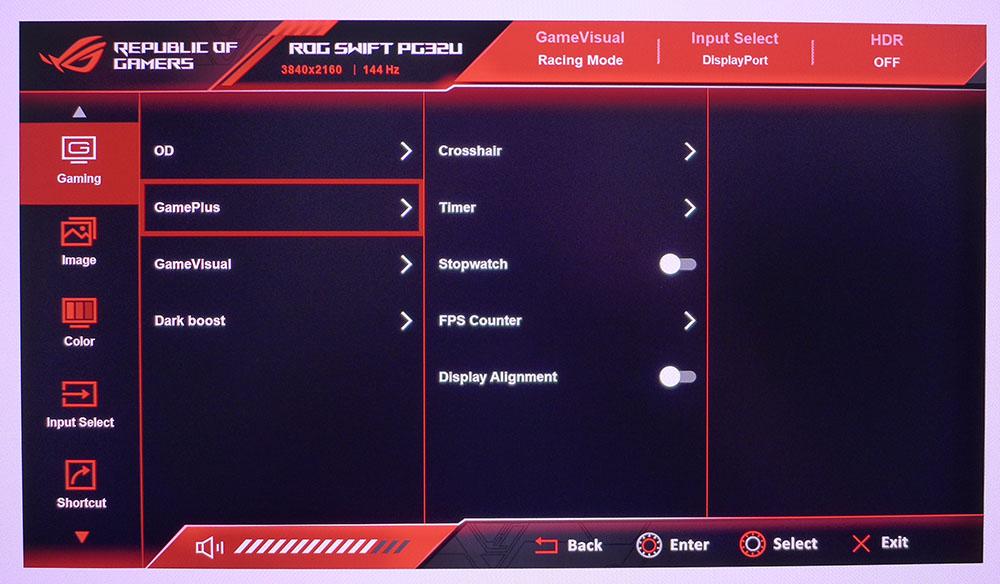

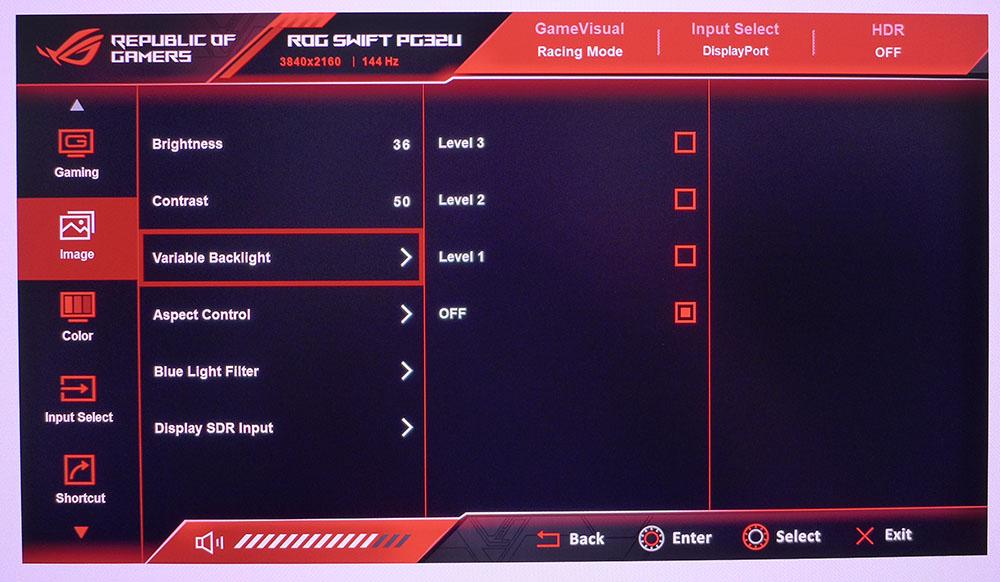
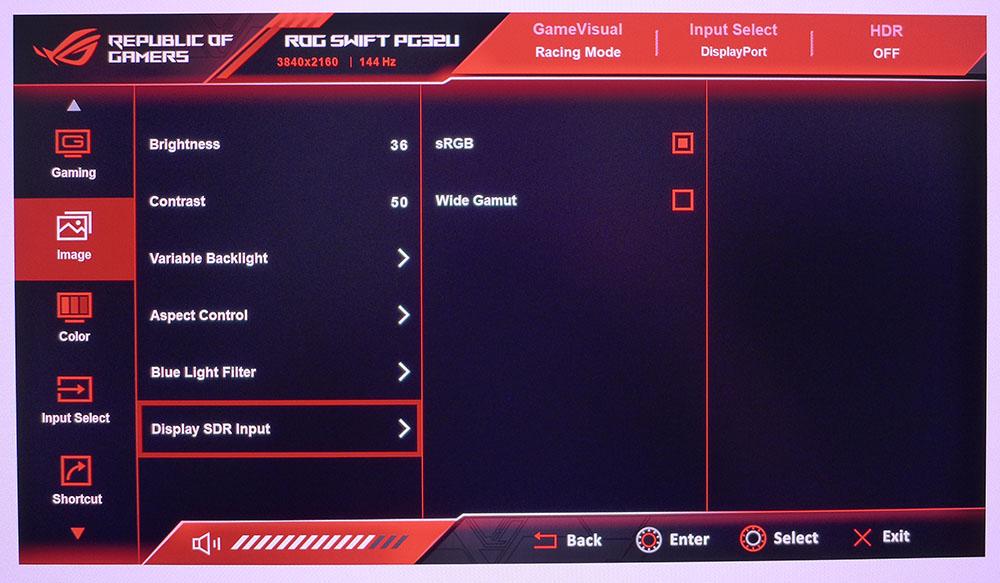


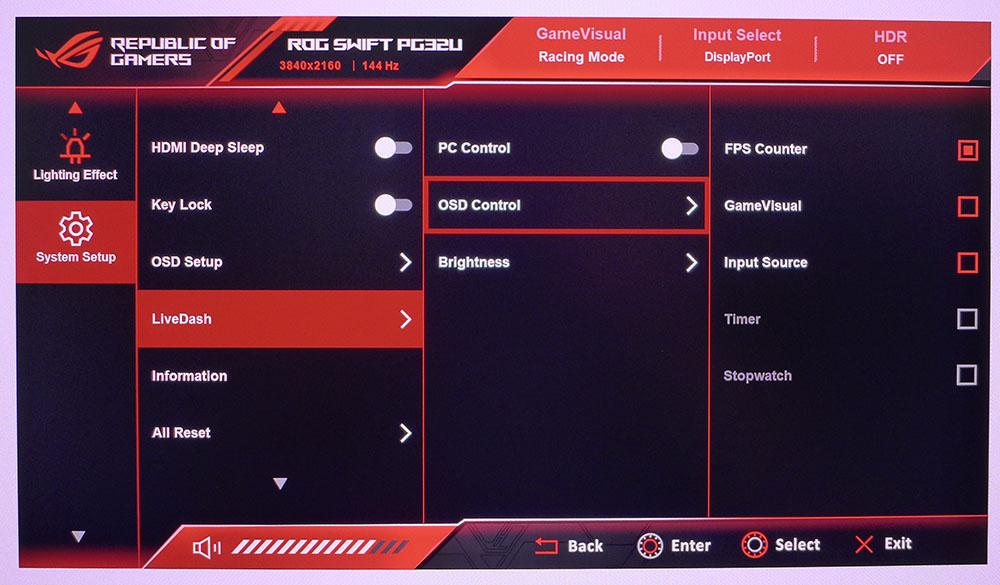
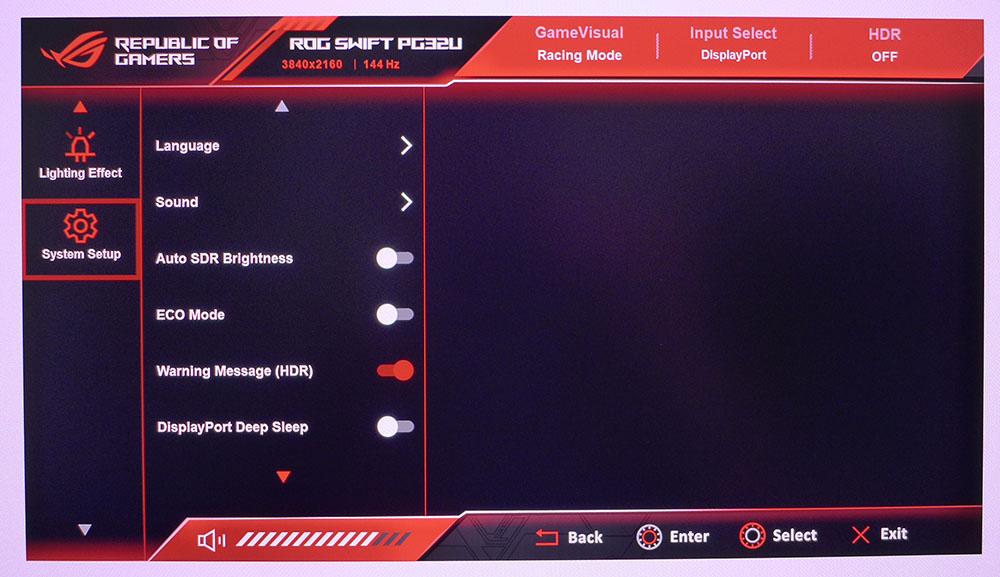
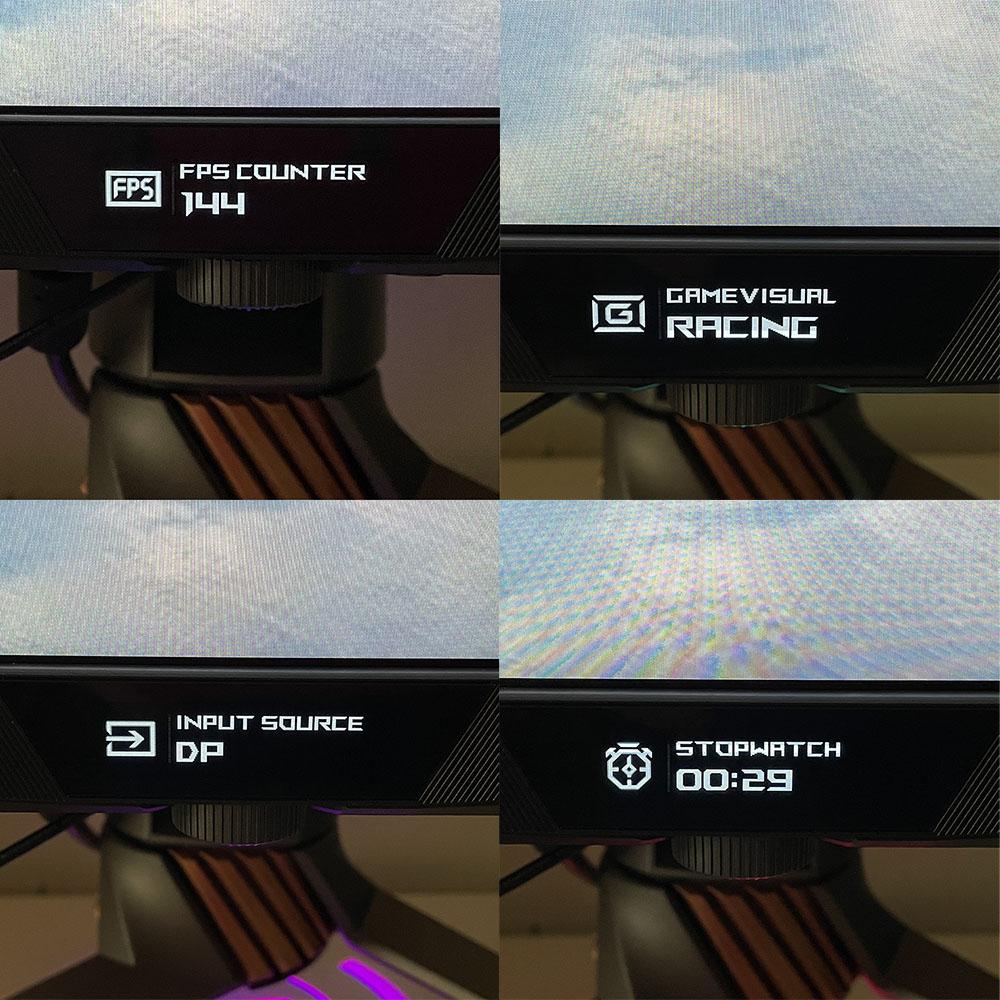
Gaming is at the top of the list with four main sections. OD (overdrive) has three levels of which number two is the best at reducing blur while avoiding ghosting artifacts. GamePlus brings an array of crosshairs, timers, a stopwatch, frame counter and display alignment marks. You can display the stopwatch, frame counter and timer on the LiveDash OLED screen as well.
GameVisual has six picture modes, all of which can be tweaked to varying degrees. The default is Scenery and a bit too far off the accuracy mark use without calibration. Racing, Asus’ usual default preset, is much better and enjoyable without adjustment. Also available is Dark Boost for brightening dark areas of the screen to improve shadow visibility.
With such a capable backlight, variable dimming, which controls how fast the backlight adjusts, based on what's on the screen, is a must. Asus offers three levels of aggressiveness. All three increase contrast subtly in SDR mode and significantly for HDR content. We measured a ridiculously high contrast ratio during the HDR tests, in fact. There is no doubt that Mini LED is superior to all other LCD backlight technologies at present. The three variable dimming levels differ in speed with Level 3 being best-suited for games. Level 2 is a good all-around setting ,and Level 1 works well for productivity.
We were glad to find Display SDR Input in the Image menu. Though its label is vague, it represents a true selectable color gamut. In SDR mode, sRGB is the correct gamut to use, but many prefer to use a monitor’s full native colors pace. The Asus ROG Swift PG32UQX covers over 100% of DCI-P3, so that results in significant SDR oversaturation. With the Display SDR Input option, you can keep sRGB for SDR and use the full gamut for HDR.
Calibration controls include six gamma presets and seven color temps, plus a User mode with RGB sliders. Setting 6500K in the Racing mode will get you most of the way there. We’ll detail our full calibration settings below.
The Lighting Effect menu lets you run the show for the stand projector and the two ROG logos. All lights are independently controlled, and you can select each one's color and effect. You can also download an app to coordinate the RGB with other Asus RGB-enabled components.
In the System Setup menu, it a toggle for the Asus ROG Swift PG32UQX’s room light sensor. It can vary screen brightness in SDR mode according to your environment. On the second screen is the control for the LiveDash at the bottom of the bezel. The OLED screen has three brightness settings too. While MSI has a similar monitor planned, the MEG381CQR, Asus' alternative is actually on the market and might be one of the coolest things we’ve ever seen on a computer monitor.
Asus ROG Swift PG32UQX Calibration Settings
Though the PG32UQX is factory-calibrated, it doesn’t ship in its most accurate picture mode. Scenery is the default and has a cool grayscale, skewed gamma and oversaturated color. The best choice whether you calibrate or not is Racing. Switching to that mode nets a visible and measurable improvement. To take it to the professional level, a few tweaks of the RGB sliders are required.
Below are our recommended settings for SDR and the Asus ROG Swift PG32UQX:
| Picture Mode | Racing |
| Brightness 200 nits | 36 |
| Brightness 120 nits | 19 |
| Brightness 100 nits | 14 |
| Brightness 80 nits | 10 |
| Brightness 50 nits | 3 (min. 36 nits) |
| Gamma | 2.2 |
| Color Temp User | Red 100, Green 94, Blue 90 |
When it comes to HDR, HDR signals lock out most image controls, but you can still calibrate the color temp or use one of the presets. In our case, we used the same RGB settings for excellent HDR accuracy.
Gaming and Hands-on with Asus ROG Swift PG32UQX
We spent a lot of time working with and playing on the PG32UQX and found no flaws in its image quality. With 138 pixels per inch (ppi) of pixel density, you can sit as close as you want without seeing any dot structure. And since the monitor has such a large field of view, you don’t have to sit super close to fill your peripheral vision with the image. Though not quite as immersive as an ultrawide monitor, a 32-inch monitor with a 16:9 aspect ratio has a distinct height advantage, making it better suited for documents, photos and watching movies.
Speaking of that, we were pleased to see that the Asus ROG Swift PG32UQX supports film cadences over its HDMI ports. That means you can hook up a Blu-ray player or streamer and view content in the correct framerate. Many movies are 24 frames per second (fps), and some TV shows are 50 fps.
We checked out several relevant demo clips and other material, and they looked sensational. High-quality presentations like Planet Earth II are simply breathtaking in 4K and HDR.
The only thing missing from the entertainment experience is Dolby Vision, which is found on 4K Blu-ray and in much of the latest content from Netflix and other providers. HDR10 looks great, but some of the newest series, like Bridgerton, take HDR to another level with Dolby Vision.
We were also able to use HDR in Windows for workday tasks without the harsh look that most other monitors impart. You can’t change the brightness setting, but most of the apps and content we looked at were rendered at a comfortable level. Small highlights were nice and bright but not too much so. Color also took on a bolder look in HDR mode, even with photos encoded in the sRGB gamut. Text-based applications were sharp and detailed with no apparent edge enhancement or softness. The Asus ROG Swift PG32UQX is a high-quality panel, and it shows in every kind of content.
As a candidate for the title of ultimate gaming monitor, it excels. It’s hard to imagine any gamer not becoming addicted to this screen. Granted, its 144 Hz might limit the most skilled competitive players who can benefit from 240 or 360 Hz. But for most of us, this is plenty of speed. Response and motion resolution are excellent, and we never noticed any motion blur. Overdrive level 2 provided sharp and clear movement. Although ULMB should be included given the PG32UQX’s price tag, we didn't truly miss it.
Tomb Raider took on a whole new look with the monitor's variable backlight on. We preferred to stick with the sRGB gamut option since it’s an SDR game, but we still enjoyed the extra contrast of the PG32UQX. Blacks were true and deep with rich detail. Highlights popped and even made us squint when looking at the sun. Now that’s realism!
Meanwhile, colors in Tomb Raider looked vibrant and natural. We tried the wide gamut option and found it too much for this game; it became a display of primary colors rather than the earthy shades that normally frame this title. This is one extended color monitor that should be used in its sRGB mode for SDR content.
Call of Duty: WWII in HDR really showed the Asus ROG Swift PG32UQX’s true purpose. This monitor sets the bar for HDR and is the display by which all others will be judged. For an LCD to truly excel and be one of the best HDR monitors, it needs a FALD backlight with a lot of zones. 384 is great, but 1,152 is even better.
We played several parts of Call of Duty: WWII in HDR to really see what $3,000 buys. Night scenes looked truly nightly with OLED-level blacks and clear shadow detail. Brightly lit indoor scenes popped with texture and reflections. In the Liberation mission, there's a building with a marble floor. It really looked like marble with a subtle texture seen in reflections from ceiling light fixtures or characters moving across it. This is as real as it gets, folks. Outdoors, sunlight really blinds the player like it would in reality. 1,400 nits is no joke. Tip: don’t look into the sun.
Honestly, it’s hard to imagine a more realistic and immersive gaming experience, even on the ultrawide and mega-wide screens we’ve reviewed. The PG32UQX raises the bar for image quality in every way.

Christian Eberle is a Contributing Editor for Tom's Hardware US. He's a veteran reviewer of A/V equipment, specializing in monitors. Christian began his obsession with tech when he built his first PC in 1991, a 286 running DOS 3.0 at a blazing 12MHz. In 2006, he undertook training from the Imaging Science Foundation in video calibration and testing and thus started a passion for precise imaging that persists to this day. He is also a professional musician with a degree from the New England Conservatory as a classical bassoonist which he used to good effect as a performer with the West Point Army Band from 1987 to 2013. He enjoys watching movies and listening to high-end audio in his custom-built home theater and can be seen riding trails near his home on a race-ready ICE VTX recumbent trike. Christian enjoys the endless summer in Florida where he lives with his wife and Chihuahua and plays with orchestras around the state.
-
Vimto94 Hello,Reply
Can you please talk about Blooming? Have you encountered any issue? Difference between this monitor and the PG27UQ on the blooming?
I want to purchase this monitor, but I read reports the haloing/blooming is bad -
truerock Reply
I think NOT having speakers inside my monitor is an extremely positive thing.Admin said:The Asus ROG Swift PG32UQX is a Mini LED gaming monitor with a tremendous feature list. It may just be the ultimate computer monitor – if you can afford it.
Asus ROG Swift PG32UQX Mini LED Gaming Monitor Review: The Ultimate Computer Monitor? : Read more
This article suggests that it is desirable to have speakers inside your monitor. I strongly disagree.
My preference is to have nothing built into my monitor except the display panel and a USB-C port. -
Makaveli Replytruerock said:I think NOT having speakers inside my monitor is an extremely positive thing.
This article suggests that it is desirable to have speakers inside your monitor. I strongly disagree.
My preference is to have nothing built into my monitor except the display panel and a USB-C port.
Ditto don't need speakers on a monitor for me personally. -
spongiemaster Reply
Agree completely. If you can afford $3000 for a monitor you can absolutely afford some decent headphones or speakers to pair with it. Leave the $2 garbage speakers out of the monitor.truerock said:I think NOT having speakers inside my monitor is an extremely positive thing.
This article suggests that it is desirable to have speakers inside your monitor. I strongly disagree.
My preference is to have nothing built into my monitor except the display panel and a USB-C port. -
ssj3rd 3.000$ and no Dolby Vision Support?Reply
I don’t get it…
Halo infinite will have Dolby Vision, for example.
I’m waiting eagerly for the Test for the PG32UQ, with a price tag 999€ it’s way more realistic and affordable. -
jakjawagon Is it common for monitors to not accept a 24hz signal? Or to display content from a blu-ray player or streaming box at the wrong framerate?Reply
I know a lot of TVs come with 'motion smoothing' on by default, but I didn't think PC monitors did.
I am not a monitor expert, but 'accepting film cadences' doesn't sound like a notable feature. -
hotaru.hino Reply
It's not common because monitors aren't expected to be used like TVs.jakjawagon said:Is it common for monitors to not accept a 24hz signal? Or to display content from a blu-ray player or streaming box at the wrong framerate?
I know a lot of TVs come with 'motion smoothing' on by default, but I didn't think PC monitors did.
I am not a monitor expert, but 'accepting film cadences' doesn't sound like a notable feature. -
Gigahertz20 Uhhhh $3k for this or just pay $1300 or so for the LG CX 4k 48" OLED...hmmm OLED please.Reply -
HyperMatrix This is a garbage monitor made using 3 year old tech. It’s the exact same as the PG27UQ with the exception of the “mini led” backlight system which isn’t that impressive either. Each zone is half the size of those on the PG27UQ. So the bloom zones will be slightly smaller, but still hugely problematic. Secondly...the price is ridiculous. $3000 for garbage. There is nothing new or cutting edge in this monitor. It doesn’t even support HDMI 2.1.Reply -
helper800 Reply
Exactly what I did except I got the 55 inch CX. At 3000 dollars I would rather have the LG G1 because its the latest and greatest OLED with as many lighting zones as there are pixels.Gigahertz20 said:Uhhhh $3k for this or just pay $1300 or so for the LG CX 4k 48" OLED...hmmm OLED please.